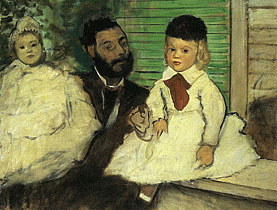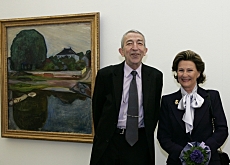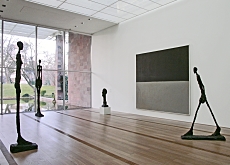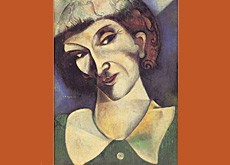Huge art heist raises questions

Police and art experts are puzzling over the audacious theft in Zurich of works by Cézanne, Degas, van Gogh and Monet valued at SFr180 million ($165 million).
The four works were stolen in broad daylight on Sunday from the private museum, the Bührle Collection. It was the biggest robbery of its kind in Switzerland – and one of the largest committed anywhere.
The three masked men who entered the building housing the valuable collection of Impressionist and post-Impressionist art are still at large, according to police.
While one of the men used a pistol to force museum personnel to the floor, the two others went into the exhibition hall and collected the paintings – Cézanne’s The Boy in the Red Vest – worth SFr100m on its own – van Gogh’s Blossoming Chestnut Branches, Monet’s Poppies near Vétheuil and Degas’ Count Lepic and His Daughters.
The museum was open at the time with around 15 visitors inside the building. The thieves loaded the paintings into a white getaway vehicle. A SFr100,000 reward has been offered for any information leading to their recovery.
“I think they knew exactly what they wanted to steal because it was over in three minutes. They came in and went directly to the right room and took the four most highly valued pictures,” police spokesman Marco Cortesi told swissinfo.
“It is one possibility that they were stolen to order, but what do you want to do with these pictures at home?” Cortesi said. “Everybody now knows these pictures have been stolen.”
He added the police could not yet say if there was a connection between this case and the robbery of two Picasso paintings from an exhibition in Pfäffikon near Zurich only four days earlier.
Ransom?
Museum director Lukas Gloor told journalists that he had not ruled out that a ransom demand would eventually be made for the works taken from the Bürhle Collection. His view is supported by international art experts.
“There have been instances in the past where valuable art works have been used as some form of bargaining chip or alternative for currency in exchange for a drugs consignment,” Sarah Jackson, research director of London’s Art Loss Register told swissinfo.
“So, it is possible that this may be the fate of the pictures, but I think we have to wait to see what leads come out of it,” Jackson added. “There is absolutely no chance of selling these on the legitimate art market.”
Swiss police said all of the paintings were secured with alarm detectors but the well-organised thieves were able to flee before the police arrived.
Re-evaluate security
Gloor said despite the security precautions, it was no coincidence that the robbers chose to hoist art from a small museum in a relatively isolated location. He said security would have to be re-evaluated at the Bührle Collection and at other, similar institutions.
“Regretfully, it has in the past repeatedly been the fact that collectors’ museums of this type have been the victims of robberies.”
The art collection of Emil Georg Bührle (1890-1956), a Zurich industrialist, is among the most important private collections amassed in the 20th century of European art.
He acquired the lion’s share in the 1950s, but a few of the works he collected during the Second World War were discovered later to have been stolen by the Nazis.
In 1960 Bührle’s family placed 200 pieces in a foundation and opened it to the public.
“There is the financial value, but there is also the spiritual value, and we are facing the fact that these paintings are some of the most important in our collection,” Gloor told swissinfo.
The biggest art robbery of all time took place in 1991 when thieves stole 20 paintings worth $500 million from Amsterdam’s Van Gogh Museum. They were found shortly afterwards in an abandoned car.
The FBI estimates the market for stolen art at $6 billion annually, and Interpol has about 30,000 pieces of stolen art in its database.
While only a fraction of pieces is ever found, the theft of iconic objects, especially by force, is rarer because of the intense police work that follows and because the works are so difficult to sell.
swissinfo with agencies
At the end of the 1980s three armed robbers made off with 21 Renaissance paintings from a Zurich art gallery. The case was made public in 1989 when FBI agents arrested two Belgians and recovered SFr6.75 million worth of stolen works.
In 1994 seven Picasso paintings worth an estimated $44 million were stolen from the Bollag gallery in Zurich. They were recovered in 2000. A Swiss and two Italians were jailed for the theft.
In 2003 a Swiss court sentenced a French man to four years in prison for the theft of art works in a six-year European crime spree. Stéphane Breitwieser was found guilty of stealing 69 works in Switzerland worth more than SFr1 million. Part of his haul was destroyed by his mother.
On February 6, 2008 two paintings by Spanish artist Pablo Picasso were stolen from an exhibition of the artist’s works at the Seedamm culture centre in Pfäffikon, canton Schwyz. The 1962 “Tête de cheval” (Horse’s head) and the 1944 “Verre et pichet” (Glass and jug), both on loan from the Sprengel Museum in Hannover, Germany, are believed to be worth several million Swiss francs.
French Impressionism and Post-Impressionism constitute the core of the collection, which also contains the Nabis, Fauves, Cubists and other representatives of the French avant-garde after 1900.
The collection is rounded off by sections devoted to earlier periods, in particular Dutch painting of the 17th and Italian painting of the 16th-18th centuries and a group of Gothic wood sculptures.
Bührle acquired most of his pictures and sculptures between 1951 and 1956. In 1960 his family placed a representative selection of about 200 pictures and sculptures in a foundation and opened it to the public.

In compliance with the JTI standards
More: SWI swissinfo.ch certified by the Journalism Trust Initiative




You can find an overview of ongoing debates with our journalists here. Please join us!
If you want to start a conversation about a topic raised in this article or want to report factual errors, email us at english@swissinfo.ch.